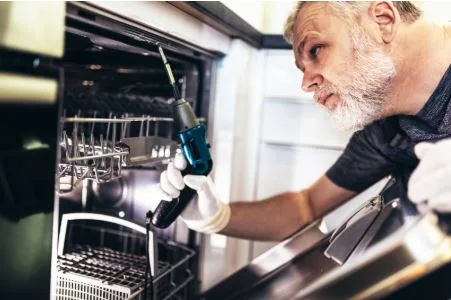How to Fix a Noisy Dishwasher in 5 Easy Steps
If you’ve ever been in the middle of a quiet evening at home, only to be interrupted by the rattling, grinding, or humming sounds coming from your dishwasher, you know how frustrating it can be. A noisy dishwasher isn’t just an annoyance—it could signal underlying issues that, if left unchecked, might lead to bigger problems down the line. The good news is that many common causes of dishwasher noise can be addressed with some basic troubleshooting and a bit of elbow grease. Before diving into more complex dishwasher repair, try these five easy steps to quiet things down. I’ve dealt with this myself a few times, and often, it’s something simple that’s causing all the racket.
In this guide, we’ll walk through each step in detail, explaining why it might be making noise and how to fix it safely. Remember, always unplug your dishwasher or turn off the power at the circuit breaker before starting any work to avoid accidents. You’ll need basic tools like a screwdriver, a flashlight, and maybe some cleaning supplies. Let’s get started and restore some peace to your kitchen.
Understanding Why Your Dishwasher is Noisy
Before jumping into the fixes, it’s helpful to know what might be causing the noise in the first place. Dishwashers operate with a series of moving parts—pumps, motors, spray arms, and valves—all working together to clean your dishes. Over time, wear and tear, improper loading, or buildup of debris can lead to vibrations, clogs, or mechanical issues that amplify sounds.
Common culprits include loose components rattling around, mineral deposits from hard water clogging parts, or even something as simple as an unbalanced load. Grinding noises might point to a worn-out pump, while humming could indicate electrical problems. Rattling often comes from dishes shifting during the cycle. By methodically checking these areas, you can pinpoint the source without needing professional help right away. I’ve found that about 70% of the noisy dishwasher issues I’ve encountered stem from maintenance oversights, so regular checks can prevent a lot of headaches.
Think about your dishwasher’s age, too—older models tend to be louder naturally, but sudden increases in noise warrant attention. If the sounds are accompanied by leaks or poor cleaning performance, it might be more than just noise. But for now, let’s focus on those five steps that can often resolve the issue quickly.
Step 1: Inspect and Clean the Spray Arms
The spray arms are like the heart of your dishwasher’s cleaning system—they spin and shoot water to blast away food residue. If they’re clogged or damaged, they can wobble, hit against dishes, or create uneven pressure, leading to banging or whirring noises. This is one of the most common fixes I’ve recommended to friends, and it’s usually straightforward.
Start by locating the spray arms; most dishwashers have an upper and lower one, sometimes a middle one too. Remove them by unscrewing the central nut or clips—check your model’s manual if you’re unsure. Once out, hold them under running water and use a toothpick or small brush to clear out any food particles, lime scale, or debris from the holes. Hard water buildup is a sneaky villain here; if you live in an area with mineral-rich water, soak the arms in white vinegar for 30 minutes to dissolve the gunk.
Reinstall the arms securely, ensuring they spin freely by hand. Run a short cycle empty to test—listen for any remaining noise. If the arms were the issue, you should notice a significant reduction in sound. In my experience, this step alone has silenced many a noisy machine, especially after holiday dinners when scraps get everywhere. If the arms are cracked or warped, though, you might need to replace them; they’re inexpensive and available at most hardware stores.
Expanding on this, consider how spray arm issues affect the whole cycle. When blocked, water pressure drops, forcing the motor to work harder, which can create additional humming or straining sounds. Preventive tip: After every few loads, give the arms a quick visual check. It’s a small habit that pays off big time in keeping things quiet.
Step 2: Clean the Filter and Drain Area
Dishwashers have filters to catch food debris before it clogs the drain, but when those filters get overloaded, water can’t flow properly, leading to gurgling, splashing, or even grinding noises as the pump struggles. I’ve seen this happen after forgetting to scrape plates thoroughly—lesson learned!
To access the filter, look at the bottom of your dishwasher’s interior. It’s often a cylindrical or flat mesh screen that twists out. Remove it carefully, rinse under hot water, and scrub with a soft brush if needed. Don’t forget the drain area around it; use a wet vac or sponge to suck up any standing water or sludge. If there’s a garbage disposal connected, run it briefly to clear any backups.
While you’re in there, check for foreign objects like bones, labels, or utensils that might have fallen in—they can rattle around and cause havoc. Reassemble everything snugly and run a vinegar cycle (pour two cups into the bottom and run on hot) to flush out residues. This not only quiets noise but improves overall performance.
One time, I helped a neighbor with this, and we found a cherry pit wedged in the filter—it was making a terrible clanging sound every cycle. Cleaning took less than 10 minutes, and the difference was night and day. If your model has a self-cleaning filter, still inspect it periodically, as they aren’t foolproof.
Diving deeper, poor drainage can lead to bacterial buildup, which isn’t just noisy but smelly too. Regular cleaning—say, once a month—keeps things running smoothly. If noise persists after this, it might indicate a deeper clog, but that’s for later steps.
Step 3: Check for Loose Parts and Secure Them
Vibrations from normal operation can loosen screws, racks, or even the dishwasher’s mounting brackets over time, turning your appliance into a mini orchestra of rattles and bangs. This step is all about tightening things up, and it’s surprisingly effective for that intermittent noise that drives you crazy.
First, with the power off, open the door and inspect the interior: wiggle the racks, spray arms (you already cleaned them, right?), and any adjustable parts. Tighten any loose screws with a screwdriver. Check the door hinges and latch too—they can creak if not aligned.
Now, look underneath: slide out the dishwasher if possible (disconnect water and power lines carefully) and examine the base. Secure any loose panels or insulation that’s come undone. The motor mount or pump assembly might have bolts that need tightening. Also, ensure the unit is level—use a spirit level on top and adjust the feet if needed. An unlevel dishwasher shifts during cycles, amplifying noise.
I remember adjusting the feet on my old unit after moving houses; it was off by just a quarter inch, but that made all the difference in reducing vibrations. If you hear noise from the sides, it could be the unit rubbing against cabinets—add foam padding if necessary.
This step emphasizes stability. Loose parts not only make noise but can cause wear on other components. If you’re handy, this is a great DIY fix, but if accessing underneath seems daunting, skip to professional advice later in the article.
Step 4: Examine the Pump and Motor Area
The pump and motor are the powerhouses of your dishwasher, circulating water and driving the cycles. If they’re faulty—due to wear, debris, or bearing issues—they can produce grinding, whining, or humming noises. This step requires a bit more caution, as it involves getting closer to mechanical parts.
Unplug the unit and remove the lower access panel (usually a few screws at the front bottom). Shine a flashlight in and look for obvious issues: debris around the pump impeller, loose belts (if your model has them), or signs of leaks. Gently rotate the impeller by hand—it should move smoothly without resistance.
If it’s gritty or stuck, clean around it carefully. For humming without action, it might be a seized motor, but that’s often beyond DIY—test by running a cycle and listening closely. Worn bearings are common in older machines and might need lubrication or replacement.
In my own kitchen saga, a faint grinding turned out to be a small pebble in the pump—removed it, and silence returned. But if the noise is deep and persistent, it could signal impending failure. Always wear gloves to avoid sharp edges.
To elaborate, pumps handle a lot of stress, especially with hard water. Descaling with citric acid every few months can prevent buildup. If this step doesn’t help, the issue might be electrical, like a failing capacitor, which is best left to experts.
Step 5: Run Diagnostic Tests and Maintenance Cycles
Once you’ve addressed the physical issues, it’s time to test and maintain. This final step ensures everything works harmoniously and catches any lingering problems.
Reassemble all parts, plug in, and run an empty cycle on the hottest setting. Listen at different stages—wash, rinse, drain. Note any unusual sounds and cross-reference with your manual’s troubleshooting section. Many modern dishwashers have built-in diagnostics: hold certain buttons to enter test mode (check your model).
Follow up with a maintenance cycle: add baking soda and vinegar to clean internals. This dislodges hidden grime that could cause noise. Also, inspect hoses for kinks or damage—they can vibrate if restricted.
I’ve made this a routine every season, and it keeps my dishwasher humming quietly (pun intended). If noise returns, log the cycle time when it occurs—it helps diagnose.
This step ties everything together, confirming your fixes. Consistent maintenance extends life and reduces noise proactively.
Preventing Future Noisy Dishwasher Issues
Now that you’ve quieted things down, let’s talk prevention. Load dishes properly—avoid overcrowding to prevent shifting. Scrape food off plates beforehand, and use the right detergent amount to minimize residue.
Address hard water with rinse aids or softeners. Keep the interior clean: wipe seals monthly and run hot cycles regularly. Listen for changes in sound early—catching issues soon saves hassle.
In humid climates, dry the interior after cycles to prevent mold, which can indirectly affect performance. Simple habits like these have kept my dishwasher reliable for years.
When to Seek Professional Help
While these steps cover most cases, some noises indicate serious problems: persistent grinding might mean a failing motor, or leaks with noise could signal pump failure. If you’re uncomfortable with DIY or the issue persists, it’s time for expert intervention.
Pros have the tools to diagnose electrical faults or replace parts safely. Plus, attempting complex fixes yourself might void warranties. Better safe than sorry—I’ve learned that from one botched repair attempt!
Common Mistakes to Avoid
Don’t ignore safety—always disconnect power. Avoid forcing parts; if stuck, use lubricant sparingly. Don’t run the dishwasher overloaded post-fix; test empty first.
Skipping the manual is a big no—models vary. And don’t use harsh chemicals; stick to vinegar or approved cleaners.
Final Thoughts on Quieting Your Dishwasher
Tackling a noisy dishwasher doesn’t have to be overwhelming. These five steps—cleaning spray arms, filters, securing parts, checking the pump, and running tests—can restore peace in under an hour. It’s empowering to fix things yourself, saving time and money.
Remember, regular upkeep is key. If all else fails, professional appliance repair help ensures longevity. Here’s to quieter kitchens and stress-free evenings!





